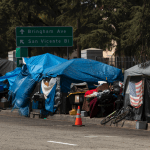Introduction
In my over three decades of heart-to-heart work with those experiencing homelessness, the importance of grounding our understanding in solid facts and figures has never been lost on me. This article, “Homeless People Statistics by Year: Trends and Insights for 2023” offers not just numbers, but a narrative—a narrative of where we’ve been, where we are, and the road that lies ahead in the past few years. These statistics are essential for us to grasp the scale of homelessness, to gauge our progress, and to identify where our efforts need to be focused.
01. Homelessness Statistics in America
The landscape of homelessness across America is as varied as the stories of those who find themselves without shelter. The latest data reveals that homelessness, unfortunately, remains a significant challenge, with more than 650,000 individuals facing homelessness on any given night in early 2023, marking a 12% increase from 2022 (U.S. Department of Housing and Urban Development, HUD Releases January 2023 Point-in-Time Count Report). This trend is a stark reminder of the work still required to address this issue.
Homelessness is not evenly spread across the country but concentrated in certain areas, with states like California, New York, and Florida housing the largest numbers of unhoused individuals (endhomelessness.org; & Security.org). These numbers underscore the urgency of developing targeted, effective solutions that can address the unique challenges of different regions.
The reasons behind these statistics are complex, influenced by a mix of economic conditions like housing market dynamics, and policy decisions. Recent years have seen a troubling rise in the number of people experiencing homelessness for the first time, attributed in part to the challenges in the rental housing market and the winding down of pandemic-era protections (U.S. Department of Housing and Urban Development).
Unfortunately, the reality is — contrary to what you may often hear — homelessness, in itself, is not a solvable problem because the underlying causes of homelessness will always be with us: drugs, alcohol, mental illness, broken relationships, and poverty. The challenge is not “How to Solve Homelessness.” The challenge is, “How do we address the underlying causes of homelessness to help those who can — and want to — be helped?” Homelessness is not a disease to be cured, but a disorder to be addressed and that is where our program, Homeless No More, shines.
Help Put Someone On The Road To A Better Life.
At Homeless No More, we’ve seen firsthand how the right approach can change lives. With a 90% success rate, our program doesn’t just offer shelter but a pathway to a better life. Our focus on holistic recovery, grounded in compassion and empowerment, has helped thousands reclaim their place in society.
The statistics are more than numbers; they represent individuals with dreams, families, and potential. By supporting Homeless No More, you’re not just giving aid; you’re restoring hope and dignity. Let’s extend our hands and hearts to those in need. Together, we can transform these statistics into stories of success and recovery.
__________
The statistics are more than numbers; they represent individuals with dreams, families, and potential.
__________
These reflections and actions are our response to the call of the statistics—a call to not just understand but to act, to not just sympathize but to empower. In doing so, we hold firm to the belief that recovery is possible, that change is achievable, and that no one should be left behind.
02. Causes of Homelessness Statistics
Understanding the causes behind these numbers is crucial for developing effective solutions. A comprehensive study by the UCSF Benioff Homelessness and Housing Initiative sheds light on the multifaceted causes of homelessness in California, a state that embodies a significant portion of the national crisis. Key findings highlight that unsustainable housing costs, with participants reporting a median monthly household income of $960 prior to experiencing homelessness, are a primary driver. The study emphasizes the critical need for affordable housing, alongside rental subsidies and one-time financial assistance, to prevent homelessness (Security.org).
The study also reveals that homelessness affects diverse populations disproportionately, with a notable overrepresentation of Black and Native Americans. Most individuals experiencing homelessness were found to be long-time residents of California, debunking myths of widespread migration for the purpose of accessing services. The aging of the homeless population and the significant challenges faced by those aged 50 or older further complicate the issue. Mental health symptoms, substance use, and experiences of violence are prevalent among the homeless population, underscoring the importance of comprehensive support services (Security.org).
Join Us in Addressing Homelessness
At Homeless No More, we are committed to tackling these challenges head-on. Our approach goes beyond temporary solutions (like immediate housing provision), focusing on long-term recovery and reintegration into society. Many leading authorities on the subject of homelessness will report the housing crisis as a number one cause of homelessness. At Homeless No More we believe there is not one, but five triggers of homelessness — drugs, alcohol, mental illness, broken relationships, and poverty — and by supporting our program, you contribute to a solution that addresses these root causes, including ensuring access to mental health and substance use treatment and addressing the five triggers of homelessness.
The statistics and stories of 2023 serve as a reminder of the work ahead. Together, we can make a difference in the lives of those facing homelessness, transforming numbers into narratives of hope and recovery.
Join Us in Reversing the Trend
As we navigate these challenging trends, the need for concerted efforts to reverse this trajectory has never been more critical. At Homeless No More, we are dedicated to addressing the root causes of homelessness, offering hope and practical solutions to those in need. By joining us, you can be part of a community that not only acknowledges the problem but actively works towards creating meaningful change. Visit HomelessNoMore.com and learn how you can contribute to reversing these trends and making a difference today.
03. The Fastest Growing Homeless Population
One of the most distressing trends in recent years is the sharp increase in homelessness among seniors, a phenomenon that has been described as the fastest-growing segment within the homeless population. Reports indicate that the aging population, particularly seniors, are experiencing homelessness at a rate that is both unprecedented and deeply concerning. Between 2017 and 2021, California saw an 84% increase in the number of individuals aged 55 and over seeking homelessness services, marking them as the group with the highest rate of increase among all age groups. This surge is attributed to a combination of factors, including economic instability, soaring housing costs, and a lack of social support systems that adequately address the unique needs of older adults. (Homelessness in America: Statistics, Analysis, and Trends, security.org.)
04. The Number One Cause of Homelessness in America
In my years at the helm of Dallas LIFE, if there’s one myth I’ve tirelessly worked to dispel, it’s the notion of a singular “number one cause” of homelessness. The reality is far more complex, woven from a fabric of diverse yet interconnected threads. The causation of homelessness, as we’ve come to understand it, is multifaceted, comprising drugs, alcohol, mental illness, broken relationships, and poverty. Each factor does not stand alone but interacts with the others, creating a web of vulnerability that can ensnare anyone under the right circumstances.
Drugs and alcohol often capture the headlines as the villains in the story of homelessness. Yet, they are more frequently the symptoms of deeper issues, such as unresolved trauma or untreated mental health conditions, rather than the root cause. Mental illness, on its own, presents a formidable barrier to stable housing, employment, and social relationships. Without adequate support and understanding, individuals struggling with mental health challenges are at a heightened risk of finding themselves without a home.
Broken relationships, whether familial or social, further exacerbate the risk of homelessness. The loss of a support network leaves many without a safety net, transforming what might have been a temporary setback into a crisis. Meanwhile, poverty – the silent undercurrent of this crisis – ensures that for many, the margin between housed and homeless is perilously thin.
In our work, we’ve seen time and again that effective intervention will not work alone. Additionally, it requires a holistic approach, one that addresses not just the immediate needs for shelter and sustenance, but also the underlying issues that contribute to homelessness.
Join Us in Our Mission
At Homeless No More, we’re committed to a mission that goes beyond the temporary alleviation of homelessness. We aim to tackle the root causes through comprehensive programs that address mental health, addiction recovery, relationship restoration, financial stability and spiritual needs. Our success is not just measured in the number of beds provided, but in the lives transformed and empowered to break the cycle of homelessness.
Your support enables us to continue this vital work. Together, we can make a lasting difference in the lives of those on the margins. By contributing to Homeless No More, you’re investing in a future where homelessness is not an inevitability but a challenge that can be overcome.
Conclusion
The rising trend of homelessness, especially among seniors, underscores the critical need for comprehensive, long-term solutions. Homeless No More is at the forefront of addressing this crisis, offering programs specifically for seniors that not just provide immediate shelter but also aim to tackle the root causes of homelessness through education, job training, health services and more.
Support Homeless No More
We invite you to join us in this vital mission. Your support enables us to expand our reach and impact, offering hope and tangible help to those in need. Together, we can work towards a future where homelessness is a thing of the past, ensuring that everyone has access to the stability and dignity of a home.
References:
- “HUD Releases January 2023 Point-in-Time Count Report.” HUD.gov. Accessed 2024. Hud.gov
- “State of Homelessness: 2023 Edition.” Endhomelessness.org. Accessed 2024.
- “HUD Releases January 2023 Point-in-Time Count Report.” HUD.gov. Accessed 2024. hud.gov
- Homelessness in America: Statistics, Analysis, and Trends, security.org.)
- https://www.kpbs.org/news/local/2023/02/10/the-fastest-growing-homeless-population-seniors
- https://homelessness.ucsf.edu/
0002






